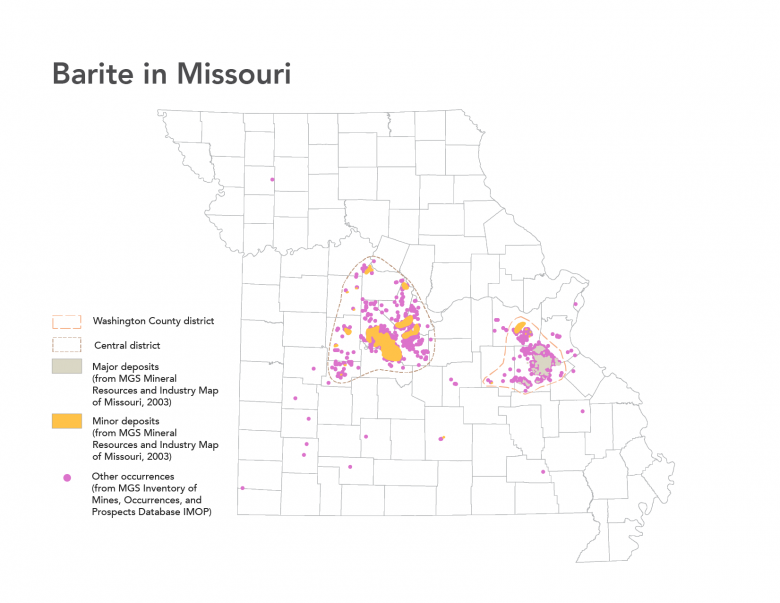
Commodity

Barite, a mineral. The word barite is derived from the Greek barus, meaning heavy.
Economic Importance: 13.4 million short tons of barite with a present value of $590 million have been mined in Missouri since the mid 1800s.
Chemical composition (chemical formula): Barium sulfate (BaSO4).
Common names: Barytes, Tiff, Heavy spar.
Primary Use

Since the 1920s, from 80 to 95% of the barite mined around the world has been consumed in the drilling of oil and gas wells. For this purpose, finely-ground barite is added as a weighting agent to drilling mud.
Other Uses
- Barite is used as an aggregate in the preparation of heavy cement and heavy concrete. Ground barite has been used as a ballast in the tires of tractors and heavy construction equipment. It has also been used to weight bowling balls.
- Barite is the main source of barium for the manufacture of barium-containing chemicals, including precipitated barite that is relatively pure. Precipitated barite is used as a filler and extender in paint, ink, paper, cloth and rubber. It is used in cosmetics, in ceramics, as a paint pigment, as a flux in glass making, and for barium meals in medical radiology.
- Barium sulfide is an important chemical made from barite. When it is mixed with zinc sulfate, a chemical reaction ensues that results in an intimate mixture of barium sulfate and zinc sulfide called lithopone, which serves as a white pigment. Lithopone was used extensively to make white paint, but its importance for that purpose declined greatly after the introduction of titanium dioxide pigments. Lithopone has also been used in floor coverings and textiles. Barium sulfide and zinc sulfate have also been used to treat wooden artifacts to give them a marble-like finish.
- Barium carbonate is used in the production of chlorine and sodium hydroxide, as a rat poison, and in special types of glass. Barium oxide is used to remove water from organic solvents. Barium nitrate is used in fireworks, as rat poison, and in ceramic glazes. Barium salts burn with a green color.
- Elemental barium, which is highly reactive, has been used in fuel cells, and it is added to the inside of electronic vacuum tubes as an oxygen scavenger.

Properties
- Color: Colorless, white, and light shades of blue, yellow, red; transparent to translucent; commonly stained superficially with red iron oxide.
- Luster: Vitreous, sometimes pearly in part.
- Cleavage: Two directions at 90 degrees; perfect in one direction and less perfect in the other.
- Hardness: 3-3½ on Mohs scale (e.g., harder than fingernail but softer than knife blade).
- Specific Gravity: 4.5 (unusually heavy for a non-metallic mineral).
- Crystal Habit: Commonly in divergent groups of tabular orthorhombic crystals that are called crested barite or barite roses; less commonly in stouter prismatic (pseudo-cubic) orthorhombic crystals.
- Solubility: Insoluble in water and not attacked by acids or bases.
- Toxicity: Barite, in and of itself, is nontoxic because of its extreme insolubility. However, elemental barium and all soluble salts of barium are very toxic.
Principal Locations of Barite in Missouri
Missouri’s principal producing area that is located about 75 miles southwest of St. Louis.Washington County District
- Major deposits are situated in Washington County and southwestern Jefferson County.
- Minor outlier deposits occur in Franklin, Jefferson, St. Francois and Crawford counties.
Central District
- Secondary producing area that is located in central Missouri south of the Missouri River.
- Minor deposits concentrated in Morgan, Moniteau, Cole, Miller, and Camden counties.
- Peripheral minor deposits occur in Cooper, Pettis, Benton and Hickory counties.
Other Occurrences
- Minor deposit located in central Texas County.
- Scattered localized occurrences located south of the Missouri River.
- Barite Production Map
- Barite Producing Regions Explanation
Geologic Occurrence
Missouri barite occurs in rocks ranging in age from Precambrian to Pennsylvanian
- Washington County district barite occurs in fractured Potosi and Eminence dolomite bedrock of Cambrian age, and in the residuum that overlies these rocks. Residual deposits average eight feet thick and are a result of the host rock weathering away, leaving a concentration of barite into an overlying veneer of red clayey residuum that is economically viable for mining. Bedrock deposits are not usually economical to mine because the barite is too dispersed and too much rock must be processed to recover the barite. These deposits are commonly associated with the ores of lead, zinc and iron.
- Central district barite primarily occurs in Ordovician-age Gasconade and Jefferson City dolomites and Mississippian-age Burlington Limestone. Barite within this district typically occurs in circle deposits. Such deposits are formed when a solution enlarged channel or cavern collapses in a conical fashion creating a bell shaped cavity that is circular in map view. Once stabilized, the ground water circulates through the structure precipitating barite and other minerals in the openings
Mining
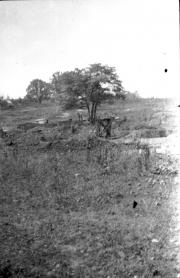
|
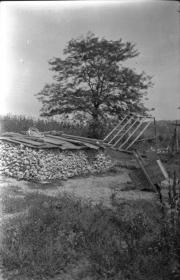
|

|

|
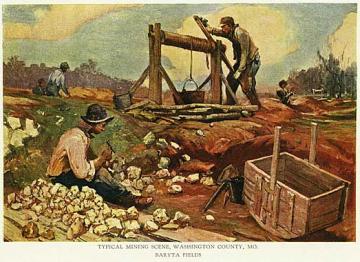
|
Barite mining in Missouri began around 1850; however, early lead mining operations began as early as 1725 in the same area, but barite was cast aside as a waste product at that time.
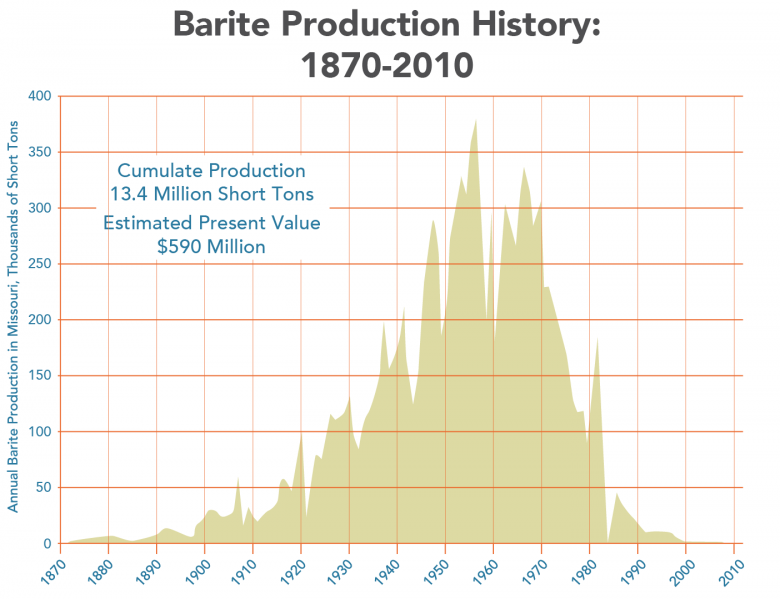
- Barite production data has been recorded from 1872 to present.
- The Washington County deposit is the major source of Missouri’s barite production.
- The Central district deposits, although sometimes high grade, are relatively small and scattered, and account for a small part of Missouri’s total production.
- Barite mined in Missouri was predominantly from open pits.
- Prior to World War I, barite was mined exclusively by hand, recovering only the larger pieces and leaving the smaller fragments behind.
- After World War I, mining by hand gave way to more modern mechanized mining methods, making recovery of smaller pieces economical. Power shovels, dragline excavators, and front end loaders became the most efficient methods of mining.
- Modern milling consists of washing, breaking, jig separation, flotation and magnetic separation of the ore from the waste rock.
Production History
Missouri led U.S. production of barite for the majority of time from 1885-1971, giving way to Nevada in more recent years.
- 1957 marked Missouri’s highest annual production at 381,642 short tons.
- Since 1872, Missouri’s cumulate production of barite is 13.4 million tons with an estimated present value of $590 million.
- Barite was last mined from Missouri in 1998.
- Barite Cumulate Production
References and Additional Reading
Search the Missouri Geology Bibliography
Visit the department’s Ed Clark Museum of Missouri Geology, where you will find barite on display.

